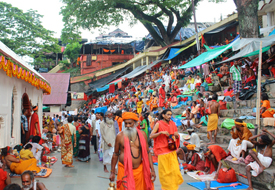Nestled in the Brahmaputra valley this state has Tantrik Shaktism, Shivaism and later Vaishnavism flourishing in its laps. From time to time people from different races, religion and culture have migrated to this place.
The Mohmmedan invasions brought Islam into the state. Sikhism flourished here, Buddhist communities have kept the flag of Buddhism flying high. The famous Gurudwara at Dhubri established by the ninth Sikh Guru Teg Bahadur is held in the high veneration by the sikhs throughout the country.
With the advent of new faith & religion many temples and monuments were built all over Assam. Most of these architectural graduers belong to the medieval period and represent the architectural style of the Koch, Kachari and Ahom royal courts. These temples and monuments, spread almost all over Assam, bear silent witness to a glorious past.
One of the holiest Hindu pilgrimages is Kamakhya temple, an ancient Shakti Peeth in Guwahati. It is the central temple in a complex dedicated to the ten Mahavidyas. The Shakti Temple of mother Goddess Kamakhya perched on the top of Nilachal Hills overlooking river Brahmaputra, is 8 Km. away from the railway station of Guwahati.
The greatest shrine of tantric Shaktism finds mention in the inscription of the Allahabad pillar of Samudragupta. Devotees from all over India converge on this holy place during Ambubashi and Manasha Puja.
At Kamakhya, Mother Goddess is worshipped in the yoni form inside the sanctum sanctorum that is a cave with rock stairs. Of several legends and myths that tell the story of temple, the most important is that Sati’s genitals fell here as her griefstricken husband Shiva carried her body hither and thither in frenetic sorrow. The hill represents the body of Lord Shiva himself and when Sati’s genitals fell here, it turned blue to become the Nilachal. Though no exact date is available to ascertain the time of establishment of the temple, archeological evidences place it around the 8th century. The present temple was rebuilt in 1565 after it was destroyed and desecrated by a Muslim invader in the 16th century, and is surrounded by many other temples dedicated to several other deities like Bhubaneswari, Kali, Tara, Chhinnamasta, Bagala, Bhairavi, Doomavati, Matangi and Kamala,all of them together with Kamakhya temple are collectively known as the Dasa-mahavidya. The Nilachal Hills also have five Shiva temples – Kameswar, Siddheswar, Amra-Tokoreswar, Aghor and Kautilinga. A pilgrimage to Kamakhya remains incomplete if one also does not visit temples of Jai-Durga, Bana-Durga,Trinath, Kedareswar, Namath-Kali,Hanuman, Ganesh, Pandunath, Smashan-Kali and Gadadhar. While a visit to Kamakhya can be made any time of the year, thousands of devotees land up during Ambubachi Mela every June. One can also offer prayers to the mighty Brahmaputra from the Nilachal Hills that offer a panoramic view of Guwahati. On the western side of Nilachal is Pandunath Devalaya. The principal deity here is Vishnu, and it was here that Vishnu had beheaded Madhu and Kaitabha, two notorious asuras or demons by placing them on his thigh. The thigh on which Vishnu beheaded them is represented by a rock, while the name Pandunath was derived from the images of the five Pandava brothers sculptured on the rock surface here. Buses from most parts of the city ply regularly to Kamakhya. It can be easily reached by auto-rickshaw as well.
 |  |  |
The week-long Ambubachi Mela is the most popular festival held every June in the Kamakhya temple complex. The festival celebrates the harmony between the reproductive female body and the cycles of nature. The temple – all others across Assam and beyond too – is closed for three days during the Mela, coinciding with the menstruation period that the Mother Goddess is believed to undergo. Ploughing ??ields or cutting earth is forbidden during these three days. The festival marks the divine Mother’s retreat from the demands of her devotees. The temple doors open after three days amid great festivity. Devotees from far and wide throng the temple, seeking a piece of red cloth offered as blessed prasad (consecrated item).
One of the reasons why Guwahati is referred to as Pragjyotishpur or the city of eastern Astrology is because of the Navagraha temple. Navagraha or the temple of nine planets is situated on a hill top in the heart of Guwahati. It is a mere 3 km away from the Railway Station. In ancient times, it was said to have been a great centre of study of astronomy and astrology. It is accessible by taxis and auto-rickshaws.
Situated in the southern-most rim of Guwahati city is Basisthashram, said to have been the hermitage of Hindu sage Vashisht. Three rivulets named Sandhya, Lalita and Kanta meet here and flow perenially adding scenic grandeur to the place. Within its complex is Janardan Devalaya, dedicated to Lord Vishnu.
It is 12 Kms. from the Guwahati Railway Station. City buses ply regularly to the Ashram.
 |  |  |